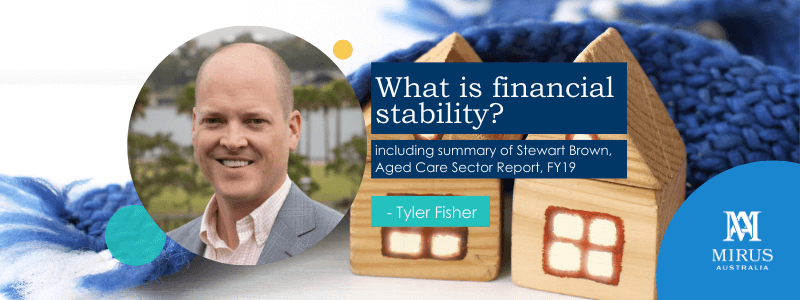What is financial stability?
October 20, 2019 | Aged Care Finance

Australian Institute of Company Directors says, “financial sustainability is core to organisation survival and success. Financial sustainability is a vital board priority. Whether you’re a director of a fast-growing organisation, a small not-for-profit (NFP), a multinational enterprise or juggling conflicting needs of a start-up, the issues and life cycles may differ, but the basic principles apply.”
Please find a summary from the Stewart Brown, Aged Care Sector Report, FY19:
- Direct care costs increased 6.2%
- Everyday living costs exceeded revenue by $8.45 per bed per day
- Non-supported accommodation revenue (RAD/DAP) increased only a fraction of the increase in accommodation supplement
- RAD/DAP – increased $0.25 per bed per day
- Supported resident accommodation supplement increased $0.72 per bed per day
- Accommodation costs increased $1.38 per bed per day
- Costs rose as expected due to staff rate increases, which accounts for 70% of the costs of an aged care home.
Forecasts for FY20, as per the Stewart Brown, Aged Care Sector Report:
- Increase of care revenue (COPE) 1.4%
- Wage increases likely to be two times COPE
So what does this mean for providers who want to become or continue being financially sustainable? Improve the care result (care revenue plus basic daily fees minus cost of care and cost of hospitality services) How?
- Acuity-based rostering: using the aggregate care requirement of a resident population to guide master rosters and decision making when filling shifts
- Optimising claiming to ensure all care requirements are being appropriately funded
Improve the accommodation result (accommodation revenue minus depreciation and refurbishment costs) How?
- Accommodation pricing is important. It is a revenue benefit (DAP) or a capital benefit (RAD) depending on the equity position of the organisation
- Understand facility-level market segments and align pricing and ratios appropriately
Accurately forecasting an organisation’s sustainability and capacity for growth requires review and understanding of capital, cash flow including exposure to validation risk and localised supply and demand. Budgeting and planning require a strategy and facility-level targets for resident acuity, staffing, room pricing, RAD/DAP ratio, supported-resident-ratio and respite utilisation.
All these targets can be determined through analysis of the available data. More unknown environmental factors like political and economic forces can have broad implications but usually happen in consultation with the industry. Adjusting forecasts and strategies can be an ongoing activity provided there is adequate technology to measure and report on performance data.
Karen Moses (FAICD) a Fellow at the Australian Institute of the Company Directors says “it’s not just about surviving but thriving. A well set up financial dashboard will give directors a short, medium and long-term view, and can help them focus on what’s material for the organisation.”
REFERENCES:
- Stewart Brown Aged Care Sector Report, FY19
- Australian Institute of Company Directors, Directors, are you on top of these 7 finance fundamentals?
Mirus Australia follows best practice policy and procedures and partners with best of breed suppliers who maintain the same rigorous approach to IT security and data privacy. Please reach out if you would like to learn more about the new Quality Standards and Australian Privacy Principles. There are many ways in which we can help increase your visibility of these issues and ensure your organisation is compliant. Consider downloading The Customer is Front + Centre resource.
Tyler (Ty) Fisher is a data nerd and proud of it. Actually, Ty is way more than a data nerd as he leads the Business Intelligence team at Mirus Australia providing expert business revenue and management process advice. Join Ty on LinkedIn.


